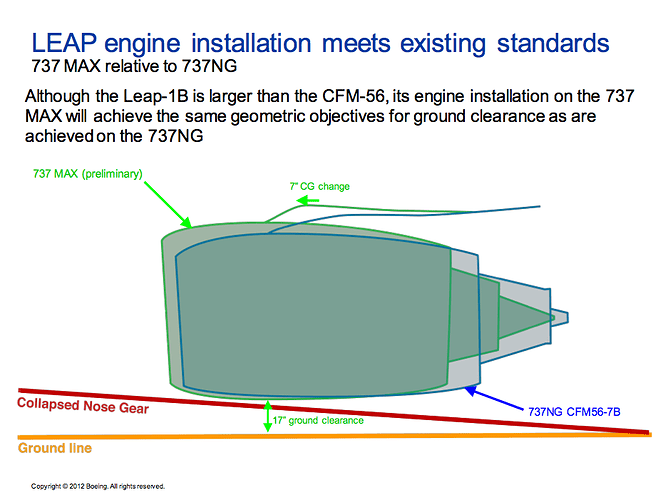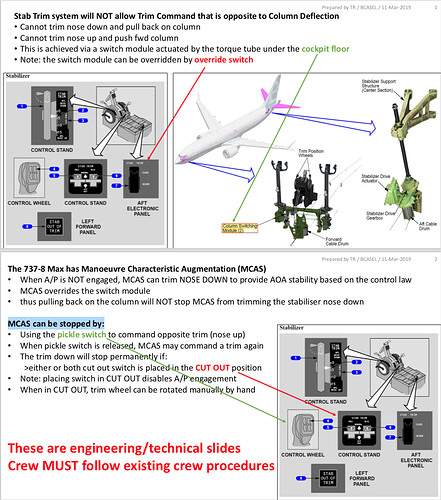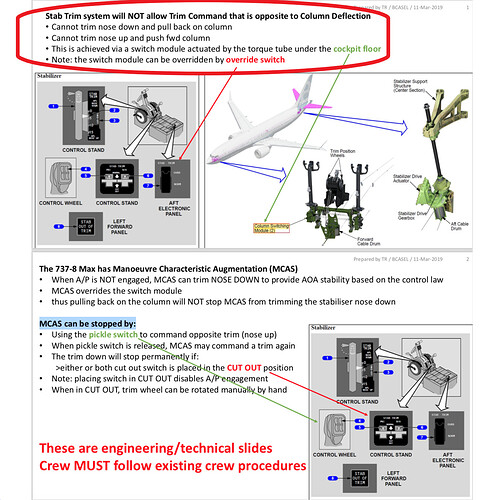finally
now USA has banned it
Inevitable, really.
The sad truth is, that despite pilots concerns regarding the MCAS system, it was ignored, and yet again, we have many lives lost.
I was under the impression that one was supposed to learn, ‘and correct’, from tragic events?, but in this case, unfortunately, it seems not 
Yes it is sad but we just have to learn from mistakes so that it no longer happens.
I just saw this on an Dutch Aviation website: “For the B737-Max, an engine was available with an even bigger diameter. To ensure that the engine could not hit the ground, the engine was pushed slightly forward and tilted slightly up! But you can understand that the aircraft then naturally wants to raise its head somewhat upwards. It is called “a high nose position”. With a high nose position you will come closer to the notorious stall. The point at which the wings no longer bear, because they cut the air too steeply.”
You want to say the mistake in design of plane is in engines?
Slightly true, as the 737 is lower to the ground, hence the ‘flat’ bottom engine type that it is famous for, and maybe when you ‘muck about’ with things, aka moving said engines, or enlarging what was already proven, then, of course, things get complicated. Could this be the cause?, who knows, maybe? Did it contribute?, possibly?
I’m sure there are other factors, like MCAS etc, lack of training, we could go on, but the bottom line is, that there is something very wrong with this aircraft, and/or attitude towards it, else we wouldn’t be in this position, and many lives would have been saved.
I really hope ‘all’ goes into this, for the sake of the people who died, and for the pilots and those who expressed concerns in the first place.
It’s a fantastic industry, and I’m sure they will get to the bottom of this, no matter what.
My girlfriends brother works as a pilot and flies the 737. According to him the 737-8MAX is a much more stable aircraft at low airspeeds than 737-800. He also said that it’s known that the MCAS system can in certain situations make the plane do unwanted maneuvers regarding altitud. But that it’s easy to override by the MCAS-Override switch and that the plane is much easier to recover at low airspeeds close to stall than the other other 737 models due to increased stability. He mostly blames maintenance and/or training standards… but i don’t know how true all of abow is, it’s just what he told me!
A schematic of the MCAS for those of u intrested.
Maybe stabilizer was broken and with a some design mistake of engine that was fatal?
Maybe pilots didn’t know about this feature
then its company mistake they dint learn the pilots to this feature.
We can think and think whats wrong with this crash and learn mistake but we can’t take back that lives.
And we can only do this ,we just have to learn from mistakes so that it no longer happens…
Lost in six minutes: Analysis of the last flight of Ethiopian Airlines
Ethiopian Airlines Ethiopian Airlines pilots fought various technical aircraft problems on a fateful day since the plane took off, says the Ethiopian authorities’ initial report on a plane disaster published this week, which on March 10 erased 157 lives.
The flight of Ethiopian Airlines lasted only six minutes and all the time the aircraft crew received countless warning signals from the airplane measuring instruments.
The desperate effort of the crew to keep the airplane in the sky turned out to be unsuccessful.
The “737 MAX 8” disaster-hit aircraft, like other “737 MAX” aircraft, was equipped with an automatic flying software Maneuvering Enhancement System (MCAS).
The initial report indicated that one of the sensors in the system was malfunctioning when sending incorrect data to the flight crew, and the sensor malfunction triggered a chain of events that ultimately led to the airplane landing.
The MCAS system automatically pushes the front of the airplane down when information is received from the sensors that the airplane is flying too slowly or its bow is too high or there is a risk of the aircraft losing speed.
However, this system can unexpectedly push the bow down unexpectedly, and so powerfully that pilots can no longer lift it.
The aircraft manufacturer, the US company Boeing, admitted an error in the operation of the Ethiopian Airlines aircraft sensor.
The company has repeatedly stressed that it is working on software updates for “737 MAX” aircraft to prevent such situations from recurring.
“It’s our duty to eliminate this type of risk,” said Boeing CEO Denis Milenburg.
In turn, former US National Transport Security Council chief Jim Hol said that the initial findings after the airplane disaster also pose an immediate need to revise the US Federal Aviation Administration (FAA) safety standards for aircraft manufacturers, including testing and testing.
The expert points out that the current arrangements that have been in force for decades are outdated.
“It is now clear that the process itself has not been able to provide a safe airplane. It is now necessary to clarify what steps have been taken in this process and which necessary tests have not been properly carried out,” Hols said.
As reported, the Ethiopian Airlines Ethiopian Airlines flight “302” landed on the morning of March 10, after departing from Addis Ababa, to travel to the Kenyan capital of Nairobi.
The original report on the causes of the disaster is 33 pages long and is mainly based on information from the black boxes of aircraft.
As the investigation progresses, the content of the initial report in the coming months is likely to change.
The initial report provides an insight into the events that took place in the flight deck after the plane took off from Addis Ababa.
One minute after the plane took off, its captain, Jared Gettachev, reported problems with the flight control system.
The MCAS system turned on later and pushed the front of the aircraft down. This process took nine seconds. Instead of continuing to take off, the airplane slightly lowered the height.
At this point, the pilots took steps to lift the front of the aircraft - for a moment they managed to get it and the plane began to take up again.
However, the MCAS system then started to push the front of the aircraft down, triggering alarms for low altitude.
At this point, the crew shut off the MCAS system and tried to manually regain control of the airplane, but they failed to get the plane to get higher.
The crew then asked for permission to return to the airport.
A moment later, the crew decided to turn on the automatic flight control system again, hoping it would help to regain control of the aircraft.
The authors of the report do not exclude that this is the last step of despair of the crew.
The MCAS system started again and pushed the airplane bow down.
But another half a minute later, the plane fell.
The “737 MAX 8” accident aircraft was received by Ethiopian Airlines alone last November.
Before the flight, the “302” had carried nearly 400 flights, totaling 1330 hours, which is very low in aviation standards.
Pilots’ experience with “MAX” aircraft was less than 160 hours of flight time.
Airplane captain Getačev was only 29 years old, but he was a pretty experienced pilot. His flight experience was over 8,000 hours. With a Boeing 737, he flew a total of 1,400 hours, and with the 737 MAX series, only 103 hours.
This is understandable, as Ethiopian Airlines had only five “MAX” aircraft, including the accident on March 10th.
The airplane second pilot - 25-year-old Ahmed Nurs Mohamod Nurs - got a license to fly with “MAX” aircraft last December - with these aircraft he had flown a total of 56 hours on airplanes.
The initial report emphasized that both pilots had completed all Boeing instructions, but they also failed to recover control of the aircraft.
Following the “Ethiopian Airlines” disaster worldwide, the use of “MAX” aircraft was halted.
Since then, Boeing has been faced with severe criticism of the inability to overcome the problems identified since the Indonesian airline Lion Air MAX 8 disaster last October.
Don't you think if Boeing knew how to fix the problem, it would already be eliminated? Already after the Lion Air disaster, they Boeing said there would be corrections, but another catastrophe had been experienced. Worldwide, but problems have not been resolved, says Hols.
-Latvian News
https://www.tvnet.lv/6562596/pazuda-sesas-minutes-ethiopian-airlines-lidmasinas-pedeja-reisa-analize
Maybe remove the MCAS
Well that seems like the thing to do, it’s a bit hard to manage that. The max Series has larger engines, which means the engines were pushed forward and raised up a bit. This causes the plane to naturally want to pitch nose up. To avoid the potential possibility of a stall, MCAS was created an added to avoid stall behaviors. That means it’s something to do with that specific software that was done wrong.
Then Boeing need to solve that.
… remember, the airlines got blamed for bad maintenace by people.
… remember, FAA and Boeing still said this aircraft is safe while it got grounded in more and more countries worldwide.
Good for Ralph, sometime you just need to make some unfunded premature decisions to stay relevant.
… and bad for Boeing Fanboys neglecting the responsibility of Boeing for their failures?
Well, technically authorities are responsible for checking the safety, not Boeing.
Nevertheless Boeing has some CSR work to be doing and should obviously deliver safe products, I just object to some of the hypocritical things from the articles. As long as investigations are still going, it is common courtesy to refrain from making a judgement as you don’t know the facts yet.
Also shareholders have many legal tools to direct the course of the company and they have insight into the processes going on internally. Complaining about the course of a company that you have been actively shaping yourself seems rather hypocritical.


